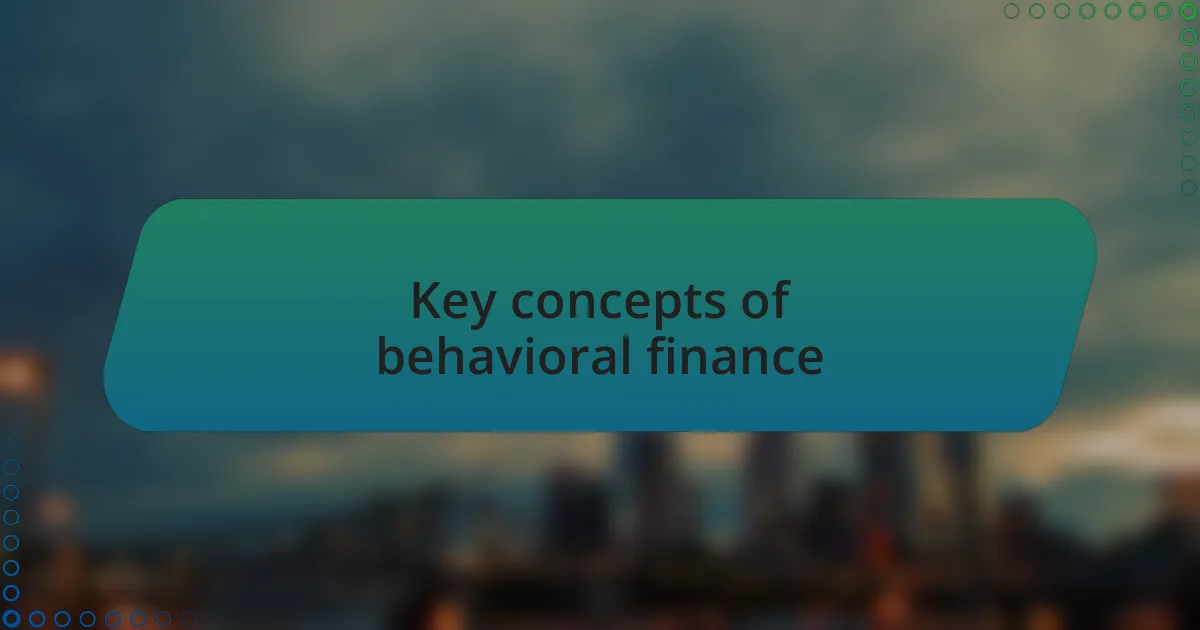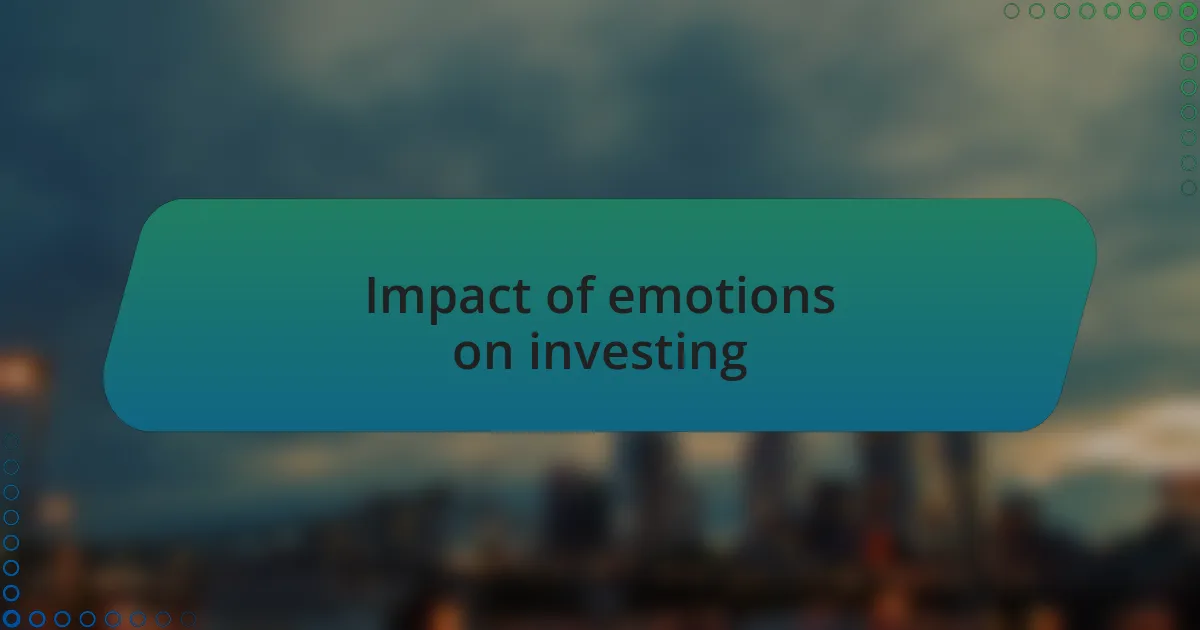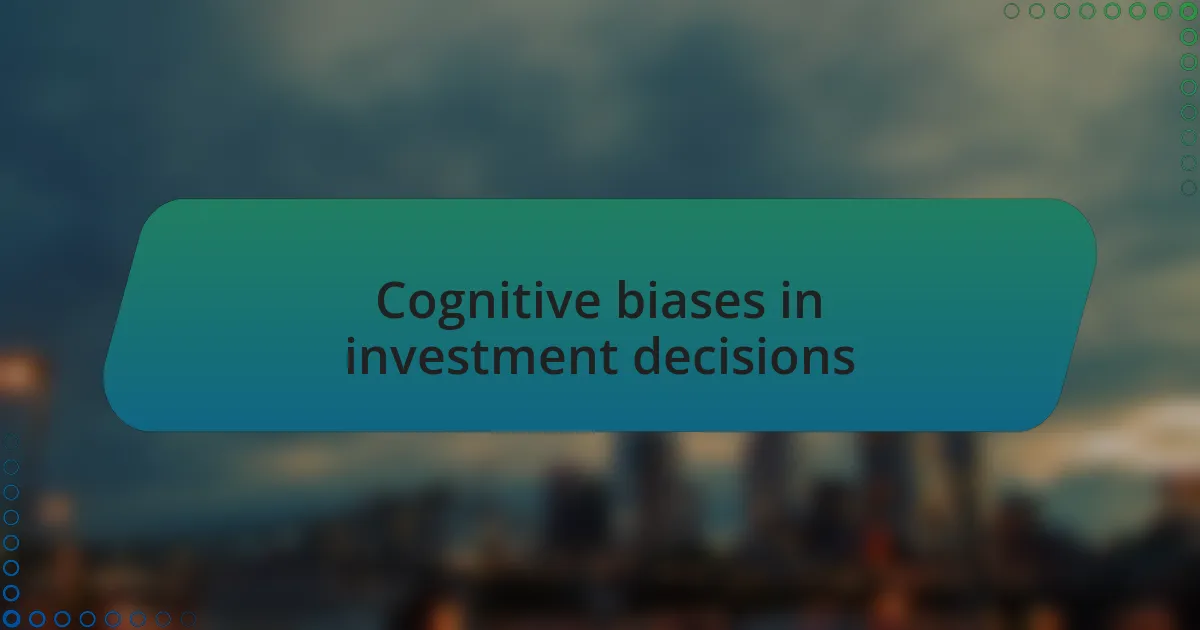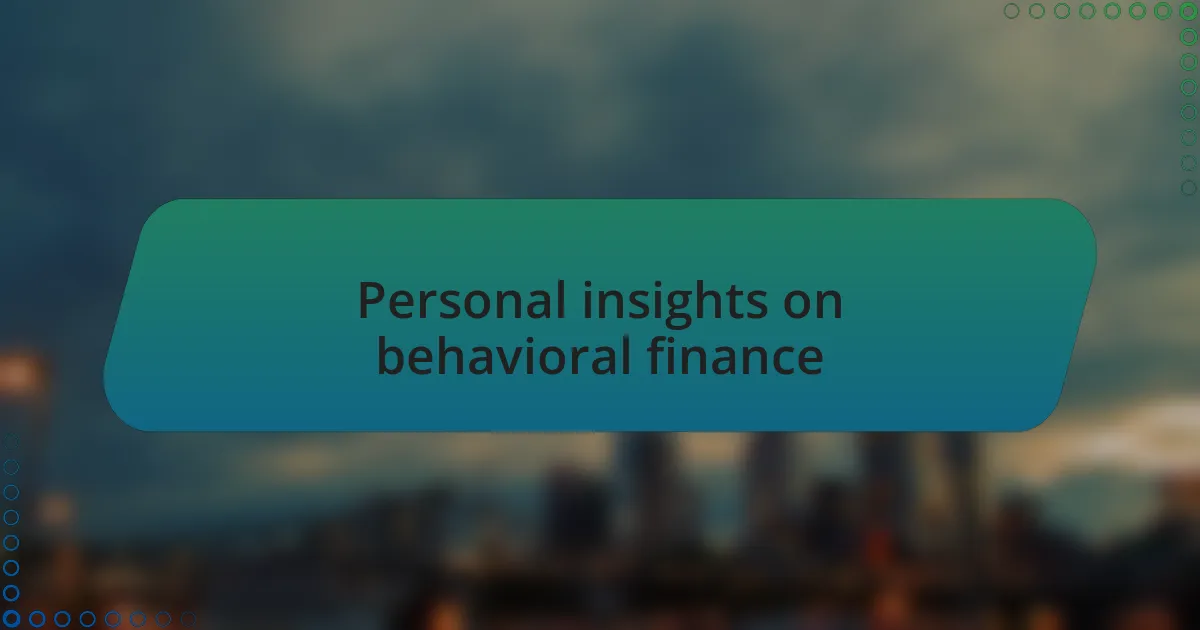Key takeaways:
- Behavioral finance emphasizes the influence of emotions and cognitive biases, such as loss aversion and overconfidence, on investment decisions.
- Recognizing biases, including mental accounting and hindsight bias, is essential for making informed financial choices.
- Strategies to mitigate biases include structured decision-making frameworks, seeking diverse perspectives, and maintaining emotional balance through practices like mindfulness.
- Documenting investment decisions and seeking accountability from mentors can enhance self-awareness and improve decision-making quality.

Understanding behavioral finance
Understanding behavioral finance means recognizing how our emotions and cognitive biases impact our financial decisions. I’ve often found myself caught up in the excitement of a market rally, only to later question why I ignored the warning signs of overvaluation. Have you experienced something similar? It’s a reminder that our feelings can cloud our judgment in ways we don’t always see.
One key aspect of behavioral finance that fascinates me is the concept of loss aversion, which suggests that we feel the pain of losses more intensely than the joy of gains. I remember a time when I held on to a declining stock, fearing actual loss more than valuing potential future gains. It made me realize how emotional reactions could keep us from making sound investment choices. This understanding is crucial for anyone looking to navigate the turbulent waters of investing.
Moreover, heuristics, or mental shortcuts we rely on, can also skew our investment choices. For instance, I’ve noticed how easily I fall into the trap of anchoring—basing my decisions on a stock’s past price, even when circumstances change. It’s an eye-opening experience that highlights the need for a more disciplined approach, reminding us that staying grounded in rational analysis can often lead to better outcomes.

Key concepts of behavioral finance
One pivotal concept I’ve come across in behavioral finance is overconfidence bias, where individuals overestimate their knowledge and abilities. I distinctly remember firing off an investment decision on a hot stock, convinced I had the inside track, only to watch it plummet. Have you ever let your gut instinct lead you astray? This experience taught me to appreciate the value of humility in investing and to seek diverse opinions before making decisions.
Another significant idea tied to our decision-making is mental accounting. This refers to the way we categorize and treat money differently based on its source or intended use. For example, I’ve noticed myself treating “bonus” money as free to splurge, while being stringent with my salary. This psychological separation can lead to irrational spending habits. How can we expect to grow our wealth if we don’t recognize the impact our mindset has on money management?
Lastly, the concept of hindsight bias often catches me off guard. It’s that feeling of “I knew it all along” after a market event unfolds. Reflecting on past decisions, I realized that this bias can distort my understanding of the risks involved. It can be tempting to assume based on what we now know, but it’s vital to acknowledge the uncertainty we faced at the time. Have you found yourself dismissing your past misjudgments as mere oversights? Recognizing these biases can empower us to learn and evolve as investors.

Impact of emotions on investing
One of the most surprising lessons I learned is just how powerful fear and greed can be in shaping investment decisions. I recall being paralyzed by fear during a market downturn, allowing that anxiety to cloud my judgment. At that moment, I realized how easy it is to sell off investments at a loss, driven by panic rather than strategy. Have you ever felt that rush of anxiety when markets turn volatile?
Conversely, when the market was thriving, I caught myself riding the wave of greed, impulsively buying into trends without adequate research. I thought I was capitalizing on opportunities, but it was more about the thrill of chasing profits. This skewed my perspective on risk management. Have you ever found yourself swept up in the euphoria of a bull market, only to face a rude awakening later?
It’s intriguing how emotions can create a cycle of decision-making that defies logic. In my experience, I found that maintaining emotional balance is crucial. I began practicing mindfulness before making investment moves, which helped me pause and evaluate my motivations. Have you considered how your feelings might be influencing your choices, even subconsciously?

Cognitive biases in investment decisions
Cognitive biases play a significant role in how we make investment decisions. For instance, I’ve often found myself overly confident after a few successful trades, a classic case of the overconfidence bias. It makes me wonder—have you ever felt invincible after a win? That feeling can lead to taking unnecessary risks, convinced that my strategy is foolproof, only to learn the hard way that markets are unpredictable.
Another bias that frequently crops up is anchoring, where our initial piece of information unduly influences our subsequent decisions. I remember fixating on the initial price of a stock I had bought, believing that it should return to that level regardless of new market conditions. It was a harsh lesson in how stubbornness can cloud judgment; have you allowed a past price to dictate your future decisions?
Finally, loss aversion has been a particularly challenging bias for me. The thought of losing money weighs heavily on my mind, often prompting me to hold onto underperforming assets instead of cutting my losses. Reflecting on this, I ask myself—how often do we let the fear of loss dictate our actions rather than making decisions based on the current market realities? It’s essential to recognize these biases to make more informed and rational investment choices.

Personal insights on behavioral finance
When it comes to behavioral finance, I’ve learned that our emotions can significantly influence our decision-making processes. I vividly remember a time when market volatility rattled my nerves; I panicked and sold shares I believed in during a downturn, only to watch them rebound shortly after. Have you ever regretted a hasty decision because fear pushed you to act against your better judgment?
Another insight that has stuck with me is how social influences can distort our investment choices. There was a period when I found myself aligning my decisions with popular market trends instead of sticking to my own analysis. I often ask myself, why did I allow the noise of others to drown out my investment convictions? It’s crucial to recognize that while peer opinions can provide value, they shouldn’t overshadow our individual strategies.
Lastly, the role of self-awareness in overcoming biases cannot be overstated. I’ve made it a habit to keep a trade journal to reflect on my decisions and identify patterns of behavior. This practice has taught me a lot about my weaknesses. Have you ever considered documenting your investment journey to gain clarity? By understanding my tendencies, I can better navigate the emotional landscape of investing, which ultimately leads to more rational choices.

Strategies to mitigate biases
One effective strategy to mitigate biases is to utilize a structured decision-making framework. I remember a time when I relied solely on instinct; it led me to overlook essential data. Since I started applying checklists and frameworks, such as the Munger Decision-Making Model, I’ve noticed a significant decrease in impulsive choices. Have you ever considered setting guidelines to ground your investment decisions?
Another approach I’ve found beneficial is seeking diverse perspectives. Engaging with a range of viewpoints, from colleagues to market analysts, has not only broadened my understanding but also helped me question my biases. I often reflect on discussions where contrasting opinions challenged my assumptions; it’s fascinating how a simple conversation can unveil blind spots. Have you experienced a shift in your thinking after hearing a different take?
Finally, embracing the concept of “slow thinking” has been transformative for me. Taking the time to pause before reacting to market news or trends encourages a more deliberate response. I recall a moment of knee-jerk reaction to a negative earnings report; thankfully, a short break allowed me to approach the situation with a clearer mindset. How often do you take a step back before making significant investment decisions?

Applying lessons in investment consulting
Applying lessons in investment consulting involves actively implementing strategies that address emotional biases. For instance, I once found myself overly optimistic during a bullish market. I realized that my enthusiasm clouded my judgment, leading me to make aggressive investments. Now, I ask myself, “Am I being rational or just swept up in the excitement?” This reflective pause has enriched my decision-making process and kept my investments grounded.
Another practical lesson is the importance of documenting my thought process when making investment choices. I recall a time when I neglected to write down my rationale for purchasing a particular stock, only to forget why I was confident about it weeks later. This experience taught me that preserving a clear record not only tracks performance but also sharpens my analysis over time. Have you considered how your investment notes might offer insights into your evolving perspective?
Lastly, I find value in the practice of “de-biasing” through accountability. By sharing my investment strategies with a trusted mentor, I’ve been able to confront my cognitive errors head-on. There was a point where I was convinced of a winning stock, but my mentor’s questioning made me reevaluate my position. This collaborative scrutiny not only enhances my critical thinking but also reinforces a sense of discipline in my approach. How often do you seek outside help to challenge your investment views?